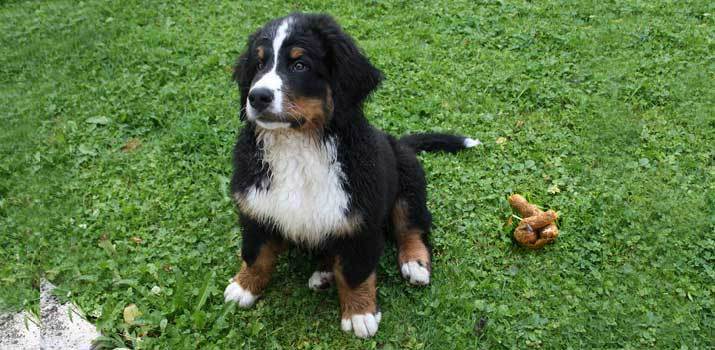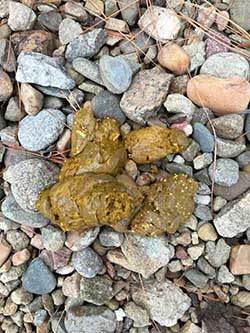Dealing with dog poop is an everyday occurrence for dog owners. While many people balk at the idea of having to handle dog poop, it's something that most of us get used to! In fact, we get so used to it that we start to observe minute changes in the feces.
This is a good thing! There's no better way to gauge the health of your dog than by examining the color, consistency, contents, and coating of their waste.
What comes out of your pup can tell you a lot about what's going on inside.

Ideally, healthy dog poop should be relatively firm and uniformly brown. So when poop goes beyond those norms, it stands out like a sore thumb!
One issue that can cause some alarm with dog owners is yellow poop. Whether it takes on a deep shade of mustard yellow or has a slimy yellow coating, yellow dog poop is not something you should ignore!
Related read: Best Dog Food to Reduce Pooping
What's the Deal with Changing Poop Colors?
Before we get into the issues with yellow poop, it's a good idea to understand why feces changes physical characteristics in the first place.
Believe it or not, color-changing feces is pretty common. Most dogs will experience consistency and color changes at some point in their life. No matter how minor the change is, take it as a sign!
As mentioned earlier, poop says a lot about your dog's health. The gastrointestinal tract is constantly working to process foods. Even when your dog is resting, it's working overtime.
All it takes is for one issue to throw the entire process out of whack. Various biological functions will impact the digestion process, leading to physical changes in the poop. Internal bleeding can darken the poop and cause red coloration.
Meanwhile, yellow and green hues are often attributed to liver and bile production! Food and waste go through many steps before making it onto your lawn. When one of those steps is altered due to health issues, the feces will reflect that.
It's always a good course of action to visit your vet when major changes rear their ugly heads. One-off issues don't require immediate care. But if the problem persists, it's always best to take your pup to a vet for some in-depth analysis.
5 Potential Causes for Yellow Poop
Causes of yellow dog poop vary dramatically. In most cases, the culprit is innocent enough. But, it could also be a sign of a serious underlying health problem.
Here are some of the most common reasons why your dog could have yellow mucus or pigmentation.
#1. Treats and Dyes
Did you recently reward your dog with a yellow-colored treat? If so, that could be the offender right there!
Dyes and intense pigments in foods are notoriously for coming out the other end unscathed. We typically see this with green-colored treats. Popular dental treats are known to cause green poop every once in a while. But yellow-colored treats can do the same thing.
Dogs aren't built to process synthetic dyes. Depending on the intensity of the color, all of the food in their stomach taking the color on.
Generally, this isn't something you need to worry about. As long as your dog isn't presenting any other symptoms, it's no big deal! That said, we always recommend trying to go dye and additive-free for treats!
Not only does it eliminate issues like colored stool, but it decreases the chances for negative reactions.
#2. Eating Yellow Objects
Like dyes, non-food objects can cause a ruckus in your dog's system. Dogs get into all kinds of trouble. Many will consume heavily pigmented objects like crayons, markers, or chalk.
The pigments in those non-edible toys will make their way into your dog's stool. The color usually looks patchy and random rather than coloring the poop uniformly.
Chances are, the color will accompany some not-so-enjoyable side-effects, too! Eating toys and art supplies can cause some serious digestion problems. Your dog's system will reject whatever they ate, causing diarrhea while your dog seems fine otherwise, vomiting, constipation, and a host of other problems!
Make sure to keep those enticing toys and household objects out of your dog's reach!
#3. Food Intolerances
Orange or mustard yellow waste can also mean that your dog is experiencing food intolerance.
This happens a lot when owners switch to a new food product. The new food may have ingredients that your dog's stomach isn't used to. Or, it may have previously unknown allergens that your pup just can't handle.

When this occurs, your canine companion will suffer from tons of indigestion and stomach pain. Typically, the feces will come out soft and may have yellow mucus.
Yellow muscus can be hard to spot at first. But upon closer inspection, the poop will look oily and slimy.
If you suspect that food intolerance is to blame, it may be time to make some dietary changes. You can visit your vet for an allergy test or do some experimentation to find the offending ingredient.
If you want to provide fast relief, go with a limited ingredients diet or bland diet. They are on the simpler side, reducing the chances of intolerance issues.
#4. Presence of Bile
Bile is a necessary substance that comes from your dog's liver. It's responsible for many things. But its most obvious impact is changing the color of waste from green to brown!
Bile pigment mixes with the waste and goes through a chemical process where enzymes transform it from its signature yellow to familiar brown.
When you see mustard-colored poop or feces covered in yellow slime, you're likely looking at that bile pigmentation. This is typically the issue when the poop is evenly colored yellow.
So what does this mean?
It means that the waste is traveling too fast through the gastrointestinal tract. The bile needs some time to go through that enzymatic change. The substance can't reabsorb fast enough, causing it to pass with the poop!
There are many reasons why this could be happening, so taking your dog to the vet is paramount.
#5. Parasites and Infections
Finally, yellow poop could be a sign of parasitic or bacterial infections in the digestive tract.
Parasites and dangerous bacteria will do a lot to ruin your pup's system. It's not just yellow coloration that you'll see! Depending on the severity of the problem, you might see blood streaks, major consistency changes, or even worms.
Yellow stool is just one of the many potential side effects. You must address potential infections as soon as possible. If left untreated, they could evolve into something even more serious and life-changing.
Is Yellow Dog Poop a Cause for Concern?
Yellow dog poop is not always an emergency. But, it doesn't mean you shouldn't treat it like a serious problem.
Any time your dog's stool isn't its normal consistency and color is a red flag. Yellow poop is alarming enough to take a trip to the vet to see what's really going on inside your dog's body.
In the worst-case scenario, it could be liver or Billary disease that's causing the color change. Cancer, pancreatic problems, or even inflammatory bowel diseases can disrupt the digestive process and cause yellow mucus to appear.
Don't ignore it! It's better to be safe than sorry.
Conclusion
Picking up dog poop is never fun. But, it provides a good opportunity to keep track of your pup's health. If you start seeing yellow dog poop out of nowhere, don't hesitate to take some action.
Keep an eye on your dog's behavior and the frequency of the yellow coloration. Then, consult with your vet to rule out any potential medical issues.
Also Read: High-Fiber Dog Foods for Healthy and Regular Digestion

